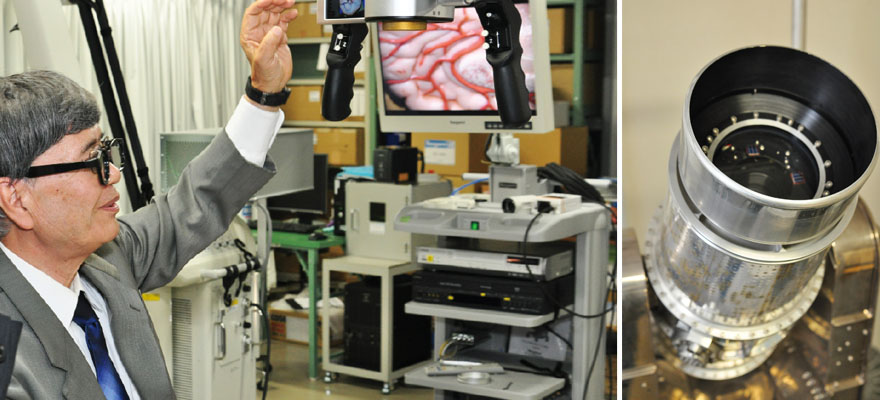Home > Highlighting JAPAN >Highlighting Japan December 2013>Japan's technological achievements
Highlighting JAPAN
Japan's technological achievements
Mitaka Kohki Co., Ltd.
On the Horizon of Innovation

Founded in 1966 on the outskirts of the Tokyo Astronomical Observatory – now the National Astronomical Observatory of Japan – Mitaka Kohki Co., Ltd. has grown from telescopes and rocket-mounted observation equipment to encompass precision three-dimensional measuring instruments, medical microscopes and solar-thermal energy systems.
Despite a modest stable of 57 full-time employees, partnership and collaboration have allowed Mitaka Kohki to touch the world. A 27-year relationship with German optics giant Leica Microsystems has netted the company half of the U.S. surgical microscope market, while efforts with the National Aeronautics and Space Administration (NASA) and the Japanese Aerospace Exploration Agency (JAXA) have put cameras on shuttles and electron spectrometers in space probes.
"I capture images in far more detail than anyone else," enthuses company president Katsushige Nakamura. He should know; he has spent his life immersed in the mechanics of observation, his father having been charged with assembling a massive astronomical telescope at the Tokyo Astronomical Observatory.
Nakamura was only 22 when he founded Mitaka Kohki with his older brother, Giichi. It was in the same year that he devised the operating mechanism for a collimator that pinpointed the position of Cygnus X-1, the first celestial X-ray source generally accepted to be a black hole.
Valuing on-the-spot innovation above all else, Nakamura's company places no premium on book learning. "We have employees who are junior high school graduates," he says. To work for Mitaka, one needs only the ability to carefully examine and re-examine a situation, and the understanding that techniques cannot be explained through words, but must be demonstrated in real-life situations.
Indeed, Mitaka Kohki's head office looks less like a think tank than an inventor's lair, with wrenches, drills and rolls of adhesive tape hanging at the ends of desks cluttered with the remains of mechanical tinkering. Job applicants must complete not only a paper test, but also a model airplane and a sketch of a naked light bulb. "I was drawing in three dimensions before I started elementary school," says Nakamura, who still prefers to illustrate his concepts by hand.
What is the secret to the company's success? "Ideas," says Nakamura. "All ideas come from putting myself in the field." He observes of Mitaka's partnership with Leica, "If it were just about the lenses, Leica would have been able to build microscopes on its own."
To start the Leica partnership, Nakamura contacted surgeons and observed their surgeries. He identified two key weaknesses in existing neurosurgical microscopes: They were so long that they got in the way of doctors' arms, and so bulky that they restricted movement in the operating room.
Coupling pragmatic zeal with space-age expertise, Mitaka's redesign enabled not only the precision to surgically connect vessels as small as 0.05 to 0.5 mm, but made the devices so compact and unobtrusive that operation durations were dramatically reduced. Mitaka now uses surgeons as spokespeople to promote
Mitaka products.
"60% of our business is in medical devices," says Nakamura. "Of the remaining 40%, 20% is in measuring instruments, and the remaining 20% is in making telescopes and energy development."
Mitaka Kohki is currently working to extract power from solar-thermal energy, using mirrors to generate heat at a single concentrated point. While photovoltaic cells can only generate electricity while directly absorbing sunlight, by concentrating and then storing heat reflected from the sun, solar-thermal systems allow power to be generated 24 hours a day, which Nakamura hopes can reduce reliance on fossil fuels.
And how did he come up with the idea? "I thought about it and said, 'If it's the sun that makes all life on earth possible, then let's go back to the sun – that great entity – to help us.'"
For Mitaka Kohki, the sun isn't the limit – it's just the beginning.
© 2009 Cabinet Office, Government of Japan






